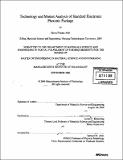| dc.contributor.advisor | Lionel C. Kimerling. | en_US |
| dc.contributor.author | Abdi, Fatwa Firdaus | en_US |
| dc.contributor.other | Massachusetts Institute of Technology. Dept. of Materials Science and Engineering. | en_US |
| dc.date.accessioned | 2007-06-28T12:23:08Z | |
| dc.date.available | 2007-06-28T12:23:08Z | |
| dc.date.copyright | 2006 | en_US |
| dc.date.issued | 2006 | en_US |
| dc.identifier.uri | http://hdl.handle.net/1721.1/37686 | |
| dc.description | Thesis (M. Eng.)--Massachusetts Institute of Technology, Dept. of Materials Science and Engineering, 2006. | en_US |
| dc.description | Includes bibliographical references (leaves 65-66). | en_US |
| dc.description.abstract | Electronic industry will suffer a major turn around in the near future. The current infrastructure will no longer be able to support the increasing data rates. All the disadvantages of copper as current legacy are amplified with the level of bandwidth we are going to experience soon. On the other hand, photonic industry is in the need of finding a new demand source to be able to bring back the state of industry to the "boom" era. With both conditions in mind, it is likely for photonic and electronic industry to emerge. However, the platform for the collaboration has not been mature enough. One of the biggest problems in the photonic industry is the high cost of the package. This, so far, has been one of the major issues holding the industry from gaining back to its golden era. In order to overcome this barrier, standardization has been suggested to be implemented in the industry. This thesis examines the current state of optoelectronic industry, as a convergence of photonic and electronic industry. More specifically, the condition of lack of standardization is analyzed and proven to be the case. | en_US |
| dc.description.abstract | (cont.) Interviewing relevant industry players and working closely with the MIT Communications Technology Roadmap-Integration, Packaging and Interconnects Technical Working Group also determine the reason of the condition. Finally, suggestions on the need of standard package and the requirement of standard package are made to hopefully direct the research towards more focused area. For the standard to be the ultimate standard, industry wide implementation has to be the resulting condition. This thesis also examines and suggests steps needed to be taken in order to promote the full implementation of the standard package. | en_US |
| dc.description.statementofresponsibility | by Fatwa Firdaus Abdi. | en_US |
| dc.format.extent | 73 leaves | en_US |
| dc.language.iso | eng | en_US |
| dc.publisher | Massachusetts Institute of Technology | en_US |
| dc.rights | M.I.T. theses are protected by copyright. They may be viewed from this source for any purpose, but reproduction or distribution in any format is prohibited without written permission. See provided URL for inquiries about permission. | en_US |
| dc.rights.uri | http://dspace.mit.edu/handle/1721.1/7582 | |
| dc.subject | Materials Science and Engineering. | en_US |
| dc.title | Technology and market analysis of standard electronic photonic package | en_US |
| dc.type | Thesis | en_US |
| dc.description.degree | M.Eng. | en_US |
| dc.contributor.department | Massachusetts Institute of Technology. Department of Materials Science and Engineering | |
| dc.identifier.oclc | 127297129 | en_US |
